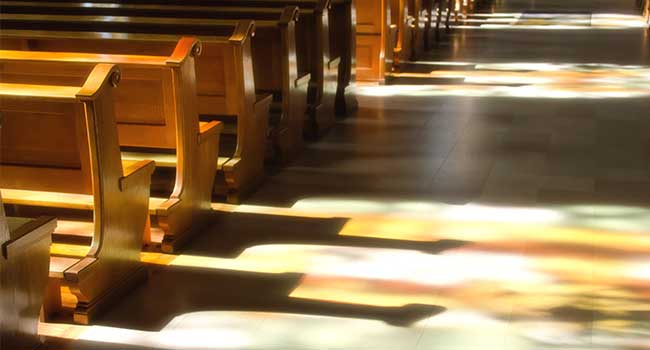
In the Spirit of Security
- By Derek Omnert
- Jul 31, 2023
Not that long ago, the very idea of a house of worship tightly controlling its doors would have been unthinkable and the antithesis of the “All are Welcome” environment such places want to create. But as we are keenly aware, the world keeps changing. So do security needs.
Vandalism, theft and tragic attacks have sadly been on the rise across the full spectrum of holy places - shrines, cathedrals, synagogues, mosques, megachurches and even their related schools. Nothing seems to be sacred.
Differences and attitudes surrounding religion have been an unpleasant fact in America since the country’s beginning. What’s newer are their waves of intensity and our greater awareness of them. The Jewish faith, as well as Christian denominations experience threats. Antisemitism has skyrocketed in the United States over the past few years. Bigotry continues toward followers of Islam. Conflicts between spiritual beliefs and mainstream culture have also created tension.
Like it or not, the universal truth today is that it is necessary for houses of worship to increase security so the faithful have peace of mind that they can continue to learn, reflect, pray and celebrate in safety and comfort.
The Shift from Always Open to Safer Openings
In some regions of the United States, churches used to be open practically all hours, even with no one around to monitor comings and goings. Some have special prayer rooms outside the main sanctuary that were accessible 24/7.
As Chris Williams, President of Corporate Security & Fire Systems, LLC explained, it was also common to keep church doors unlocked from just before Sunday morning services until nine at night.
“Church staff would dog a door device with a hex (Allen) key to keep the latch bolt retracted and enable a push/pull operation, removing the need to use a lever or panic bar to open a door,” Williams said. “Sometimes the person who dogged the mechanisms would forget to return to lock up. That meant doors would remain unlocked until Tuesday since Mondays are usually a day off for church staff.”
However, by the early 2000s, access control systems started to be deployed in houses of worship, especially as other security technologies beyond fire alarms began to emerge.
Williams said doors are now on access control schedules. “They are unlocked just before service, and then most doors are locked during service except for possibly the main entrance where someone is stationed to greet a late arriving person. Often that greeter is an authorized church member. But it could also be someone from a security team that some larger churches have.”
Larger houses of worship are often in use up to 16 hours a day every day, and have a variety of meetings, group sessions, community activities, weddings, and other events that make beneficial use of the multi-purpose spaces within buildings. This is when ease of use becomes just as important as security and why access control systems have become so helpful in these settings. Administrators want to avoid handing out brass keys that frequently left behind or lost; they want card credentials that can be issued, modified and revoked easily.
Mega Spaces Mean More Members, Increased Activities, and Greater Security Measures
Synagogues and megachurches with large congregations have lots of doors to cover and can require up to one hundred or more video cameras. Typically, there is a camera wherever there is a card-controlled access point, so if one of these doors is breached, footage of that opening can be reviewed.
Parking lots also use surveillance video – most with license plate recognition capability in case there is a fender bender, intrusion, or act of vandalism that needs a follow-up investigation.
Houses of worship usually have classrooms for Sunday or Hebrew school sessions or associated and/or adjacent private schools. Thankfully, most now have locks that can be secured from either side of the door and feature status indicators that make it clear if a door is locked. Many organizations also have check-in kiosks where children and visitors receive a badge and then can be escorted to a classroom or specific destination for the day.
According to Williams, facilities with double-door entrances are now removing levers and pulls from the inactive side’s exterior to prevent someone from using the hardware to chain or tie the doors closed.
“Expansive buildings and grounds can be difficult to monitor both during the day and after hours,” Williams said. “That’s why larger houses of worship are installing panic buttons in strategic areas that can be activated to put the building in secure mode if an unauthorized person is somewhere he or she should not be, or there is an emergency or problematic incident underway.”
Dov Israeli, managing partner at Precision Lock and Safe, explained how a synagogue he worked with in New York obtained a grant from Homeland Security to reinforce and harden its aging facility. “Old wooden and failing doors in the 80+-year-old temple were replaced with special metal doors, frames and locks, including solutions like Yale SquareBolt® exit devices that help resist impact and pull force to deter intruders and allow time for help to arrive.”
He also says that the synagogue has had security window film applied to their preschool glass classroom doors, and ballistic-rated glass is planned for main entrances and lobby areas. He adds that newer aesthetic finishes now available for doors, frames and hardware provide architectural continuity to maintain the peaceful, comfortable and established spiritual environment for the more than 2,500 congregation, while bolstering security to improve a sense of well-being.
Houses of worship are, after all, supposed to be tranquil and uplifting; inspiring and a source of strength, not a stronghold; a place for communion and community; and safe and secure while also being convenient and, of course, welcoming.
This article originally appeared in the July / August 2023 issue of Security Today.